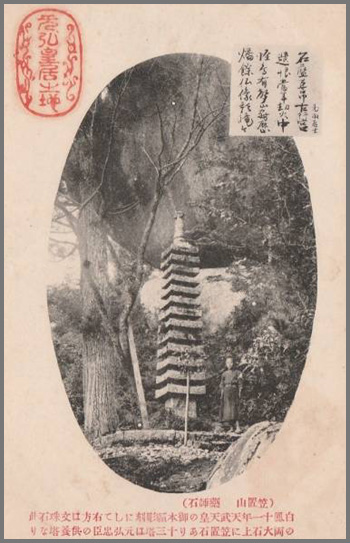. Gofunai 御府内八十八ヶ所霊場 88 Henro Temples in Edo .
::::::::::::::::::::::::::::::::::::::::::::::::::::::::::::::::::::::::::::::::::::::::::::::::::::::::::::::::::::::::::::::::::::::::::::::::::::::::::::::::::::::::::::::
. Enma Ten, Enma Oo 閻魔天、閻魔王 Emma King of Hell .
Temples in his honor are usually called Enmadoo 閻魔堂 Emma-Do, Emma Hall.

The statue of Enma is 3,5 m high and 4,5 m wide. (Said to be the largest in Japan.)
If people throw coins in the box for offerings (saisenbako 賽銭箱), the halo in the back of the statue lights up and flickers for a while. The statue is therefore called
ハイテク闇魔 Hi-Tech Enma.
. Fukagawa "深川ゑんま堂" Fukagawa Emma-Do .
Gofunai Henro Nr. 74 - Hoojoo-In 法乗院 Hojo-In
- 賢台山 Kentaizan 法乗院 Hojo-In 賢法寺 Kenpo-Ji
法乗院えんま堂 Hojo-In Enma-Do -
江東区深川2-16-3 / Kōtō ward, Fukagawa, 2 Chome−16-3
..............................................................................................................................................
Apart from this one, there are three important Emmado temples in Edo (introduced below)
江戸三大閻魔 / 江戸三閻魔
- 華徳院 Ketoku-In - Suginami
- 太宗寺 Taiso-Ji - Shinjuku
- 善養寺 Zenyo-Ji - Toshima
::::::::::::::::::::::::::::::::::::::::::::::::::::::::::::::::::::::::::::::::::::::::::::::::::::::::::::::::::::::::::::::::::::::::::::::::::::::::::::::::::::::::::::::
Ketokuin 華徳院 Ketoku-In (Katoku-In)
- 称光山 華徳院 Ketoku-In 太宗寺 Taiso-Ji
杉並区松ノ木3-32-11 / Tokyo, Suginami, Matsunoki, 3 Chome 32-11
天台宗 Tendai sect

source : goshuin.net/edo3emma-ketokuin
It was founded in 下野国佐野 (now Tochigi, Sano town 栃木県佐野市)by . Ennin 円仁 - Jigaku Daishi 慈覚大師 / 慈覺大師 . - (794 – 864)
It was called 蔵前の閻魔堂 Kuramae no Enmado.
The main statue was made by 運慶蘇生 Unkei and is in the center. To its richt is a statue of the same wood of 奪衣婆 Datsueba, the "Hag of Hell", and to its left a statue of 本地化馬地蔵尊 made by 聖徳太子 Shotoku Taishi.
The temple and the statues burned down during the great earthquake in 1923.
The temple moved to its present location in 1929.
A new statue of Enma was given by 日光輪王寺
- HP of the temple:
- source : tesshow.jp/suginami -
::::::::::::::::::::::::::::::::::::::::::::::::::::::::::::::::::::::::::::::::::::::::::::::::::::::::::::::::::::::::::::::::::::::::::::::::::::::::::::::::::::::::::::::
Taisooji 太宗寺 Taiso-Ji
- 霞関山 本覚院 太宗寺 Taiso-Ji
新宿区新宿2-9-2 / Tokyo, Shinjuku 2-9-2
浄土宗 Jodo Sect
The main statue is 阿弥陀如来 Amida Nyorai.

source : goshuin.net/edo3emma-taisoji
- History
Founded in 1596 at the beginning of the Oshu Kaido highway by priest 太宗 Taiso. One of the Six Jizo of Highways:
Nr. 03 - . Edo Roku Jizo 江戸六地蔵 The Six Jizō Bosatsu of Edo .
- Other Pilgrimages
新宿山之手七福神の布袋尊 Shinjuku - Shichifukujin - Hotei
- HP of the temple:
- source : tesshow.jp/shinjuku -

太宗寺不動堂 Fudo Hall

太宗寺塩かけ地蔵 Shiokake-Jizo -Jizo to throw salt at
When making a wish, people throw some salt on the statue. When the wish has been granted, they come back and throw even more salt at Jizo.
. Jizō - Jizo Bosatsu 地蔵菩薩 - Introduction .
::::::::::::::::::::::::::::::::::::::::::::::::::::::::::::::::::::::::::::::::::::::::::::::::::::::::::::::::::::::::::::::::::::::::::::::::::::::::::::::::::::::::::::::
Zenyooji 善養寺 Zenyo-Ji
- 薬王山 Yakuozan 延寿院 善養寺 Zenyo-Ji
豊島区西巣鴨4-8-25 / Tokyo, Toshima, Nishisugamo, 4 Chome 8-25
Shingon sect
The main statue is 薬師如来 Yakushi Nyorai.

source : goshuin.net/edo3emma-zenyoji
This temple was founded around 830 by 慈覚大師 Jigaku Daishi in Uenoyama, as 上野東叡山寛永寺末 a sub-temple of the Ueno Kanei-Ji.
It was moved to 下谷区善養寺町 Shitaya, Zenyojicho around 1670. To make room for the railway it was moved to ist present location in 1912.
The wooden statue of Enma is about 3 meters high,
- HP of the temple:
- source : tesshow.jp/toshima -
. Ennin 円仁 - Jigaku Daishi 慈覚大師 / 慈覺大師 . - (794 – 864)
.......................................................................
There is another temple named 善養寺 Zenyo-Ji in Tokyo
Tokyo, Edogawa ward, Higashi-Koiwa 2-24-2
In the compound are various stone memorial monuments, like 石燈籠 stone lanterns and 宝篋印塔 grave markers.
The grave of the potter and painter 尾形乾山 Ogata Kenzan (1663 - 1743) is in the compound.
In the compound is also an old pine tree of more than 600 years, 影向のマツ Yogo no Matsu.
.......................................................................
There is another temple named 善養寺 Zenyo-Ji in 滋賀県 Shiga, 高島市 Takashima city
Makinocho Hiruguchi, Takashima, Shiga
It comes with a legend of a fox:
The priest of 善養寺 the Temple Zenyo-Ji had been looking after a fox family.
To show his gratitude, the fox told him how to prepare medicine.
The medicine was very useful and the temple became rich by selling it.
Even the fox sometimes went out to sell it.
. kitsune densetsu 狐と伝説 fox legends .
::::::::::::::::::::::::::::::::::::::::::::::::::::::::::::::::::::::::::::::::::::::::::::::::::::::::::::::::::::::::::::::::::::::::::::::::::::::::::::::::::::::::::::::
- reference source : tesshow.jp/edo3enma_index -
- reference : 華徳院 -
- reference : 太宗寺 -
- reference : 善養寺 -
::::::::::::::::::::::::::::::::::::::::::::::::::::::::::::::::::::::::::::::::::::::::::::::::::::::::::::::::::::::::::::::::::::::::::::::::::::::::::::::::::::::::::::::
. Juu Oo 十王, Juo, Ju-O - 10 Ten Kings of Hell .
. Pilgrimages in Edo - Tokyo .
- Koya San in Wakayama 和歌山 高野山 -
- Kobo Daishi Kukai 弘法大師 空海 (774 - 835) -
. Gofunai 御府内八十八ヶ所霊場 Pilgrimage to 88 Henro Temples in Edo .
- Introduction -
::::::::::::::::::::::::::::::::::::::::::::::::::::::::::::::::::::::::::::::::::::::::::::::::::::::::::::::::::::::::::::::::::::::::::::::::::::::::::::::::::::::::::::::

. Join the Updates of Facebook ! .
::::::::::::::::::::::::::::::::::::::::::::::::::::::::::::::::::::::::::::::::::::::::::::::::::::::::::::::::::::::::::::::::::::::::::::::::::::::::::::::::::::::::::::::
. Japan - Shrines and Temples - ABC .
. Welcome to Edo 江戸 ! – The Edopedia .
[ . BACK to DARUMA MUSEUM . TOP . ]
[ . BACK to WORLDKIGO . TOP . ]
- - - - - @edopilgrims #enma #emmado #enmaedo - - - - -
::::::::::::::::::::::::::::::::::::::::::::::::::::::::::::::::::::::::::::::::::::::::::::::::::::::::::::::::::::::::::::::::::::::::::::::::::::::::::::::::::::::::::::::














































